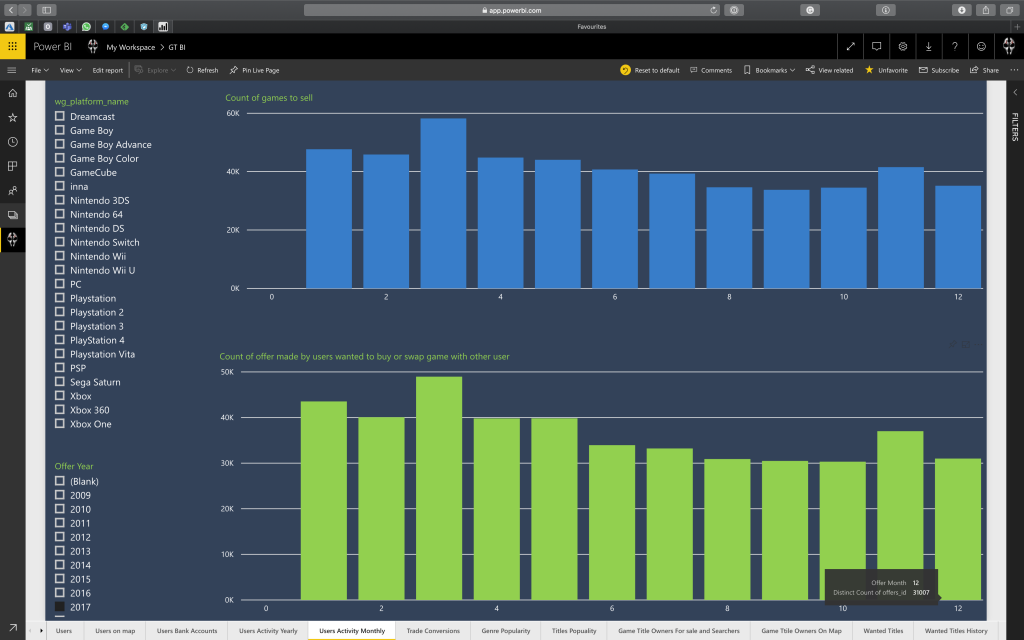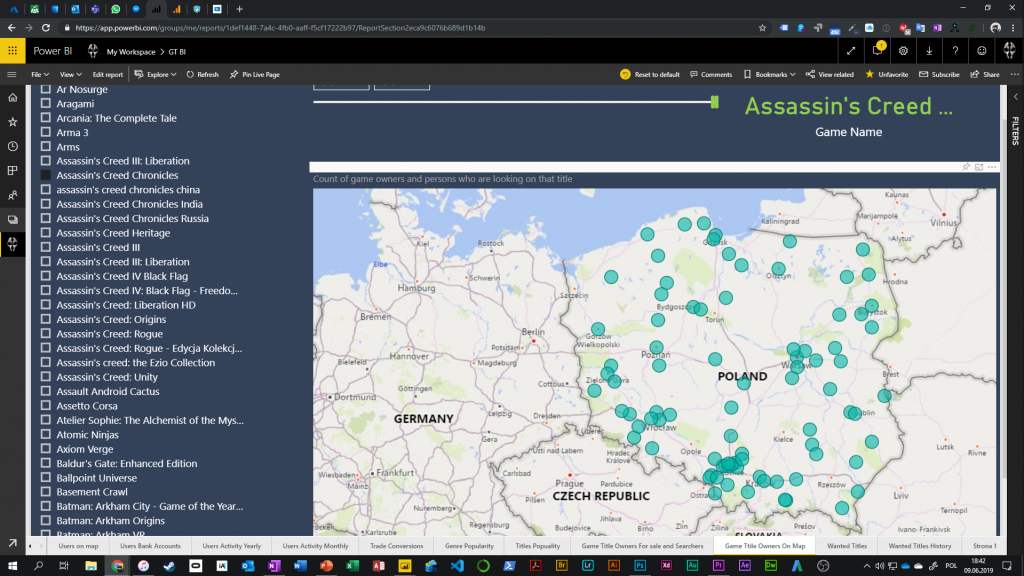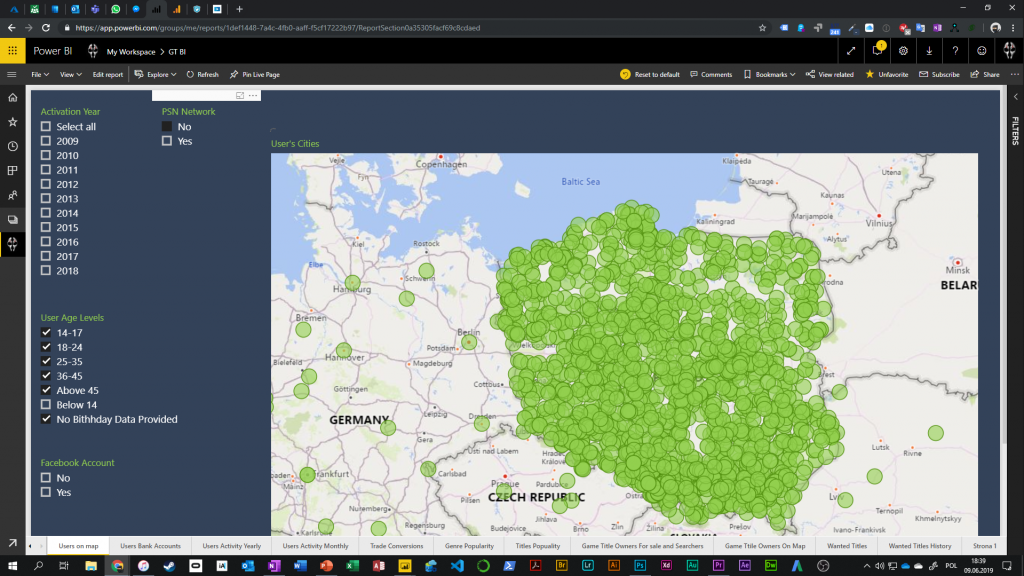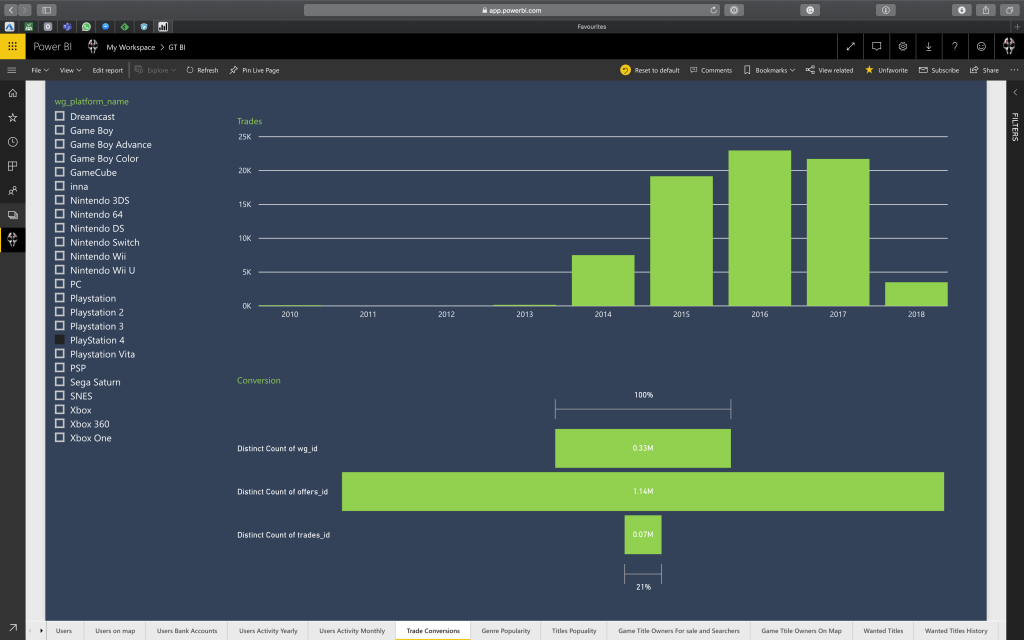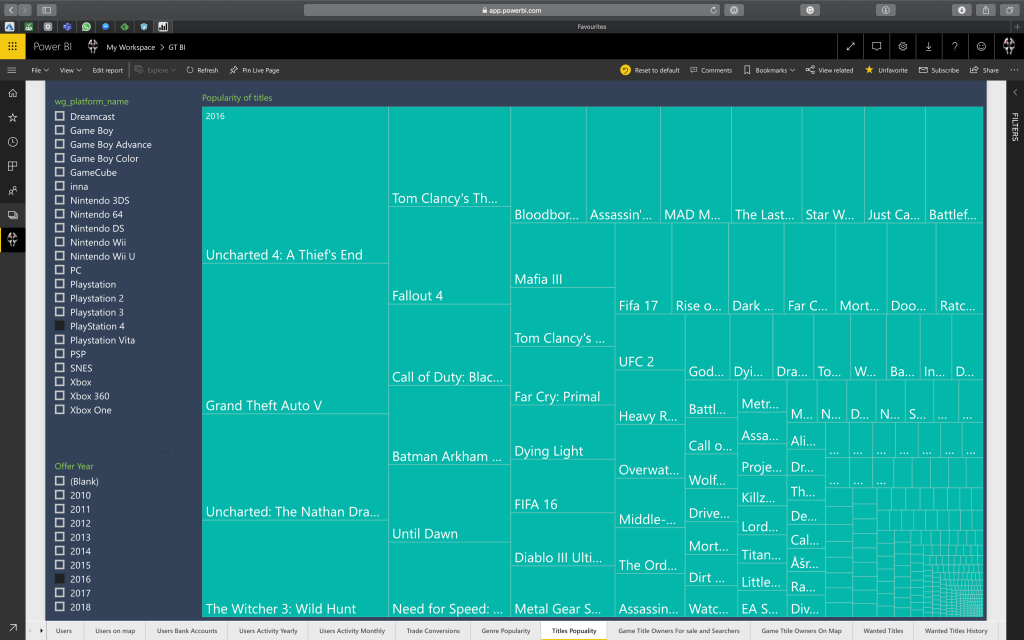

Analysis of Platform User Data – Power BI Dashboards
Implemented in 2016.
The created sets of dashboards in Power BI demonstrate analytical capabilities based on historical data from a portal enabling the sale and exchange of video games.
The summary was prepared using over half a million records, aggregated and transformed with Power Pivot and DAX formulas.
Key visualizations:
1. User migration process between console generations (PS3 → PS4)
The report presents how, over several years, users migrated from the PlayStation 3 platform to PlayStation 4, analyzing game listing activity and the number of owned titles by registration year.
2. User age vs. number of owned games
Age segmentation was used to show which demographic groups were most active in terms of the number of games assigned to an account. Column and pie charts enabled analysis of the gaming community’s structure.
3. Account registrations over the years
The dashboard displays the number of registrations in particular years, including user age and links between accounts, Facebook, and PSN. It is a valuable source of data for assessing the effectiveness of marketing campaigns and changes in consumer behavior.
4. Visualization of offer activity over time
Dynamic charts make it possible to track month-by-month and seasonally how the number of sent offers (sale/exchange) changed. Additionally, the report analyzes offer effectiveness—how many ended with a transaction.
5. Geolocation of users and transactions
Map visualizations allow segmentation of users by:
- location,
- age,
- Facebook account presence,
- registration year.
A separate view also shows the geolocation of holders of specific game titles (e.g., Assassin’s Creed series), allowing analysis of brand interest at the regional level.
6. Effectiveness and offer conversion
A dedicated screen presents conversion metrics—what percentage of listed offers led to a completed exchange or sale. This enables evaluation of user activities by platform and time.
Reports prepared in Power BI summarize users by age and the number of games they own.
Power BI Dashboard
Interactive visualization of user registrations by age, registration year, and account activity.
The presented report shows not only the community’s age structure but also:
- the number of owned games by age group,
- account links with external services (e.g., Facebook),
- registration trends across years, broken down by age segments.
The visualizations used (column and pie charts) allow for quick identification of the most active user groups and an understanding of how age influenced engagement with the platform. This is an example of effective use of Power BI to create a tool supporting business decision-making and product strategy.
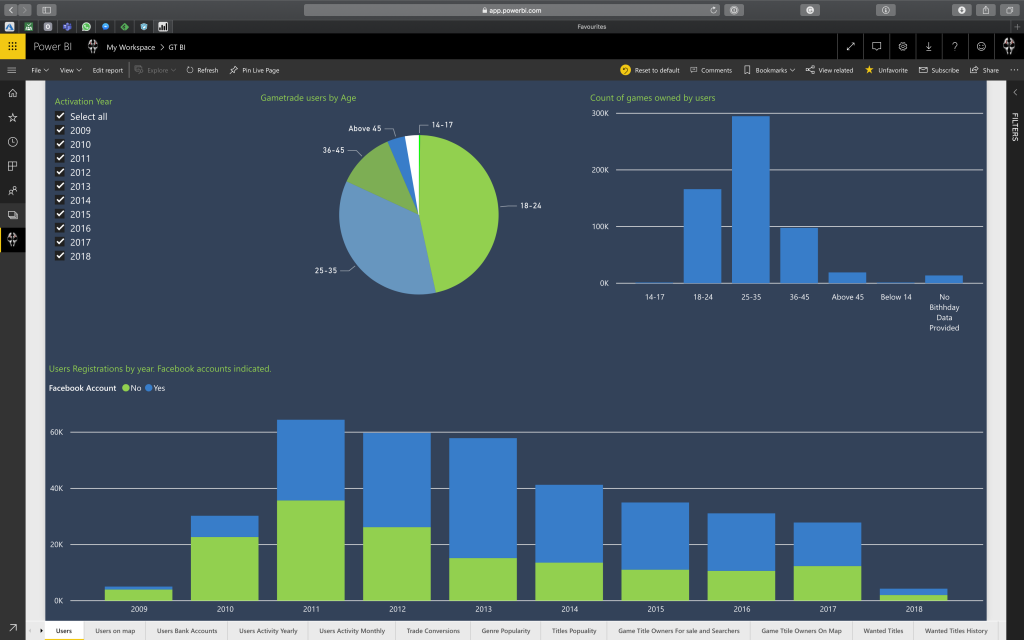
Power BI User Activity Visualization
This report presents an analysis of user offer activity on a monthly basis—covering both the number of games listed for exchange and offers made for other users’ games.
By combining these two metrics on a shared timeline, you can:
- identify the seasons of highest transactional activity,
- spot differences between demand and supply in specific periods,
- better understand the platform’s rhythm and community behavior.
The visualization enables filtering by platform (e.g., PS3, PS4, Xbox) and year, allowing for a detailed analysis of gamer preferences over time.
Interactive map showing where players owning specific games are located
This simple yet extremely useful visualization allows you to identify the distribution of owners of selected titles, such as the Assassin’s Creed series, on the map of Poland.
With filters, you can:
- select a particular game from the list and immediately see its geographical reach,
- analyze the regional potential for a title’s popularity,
- identify concentrations of active users, which can be the basis for targeted offers, promotional actions, or local campaign testing.
This is an excellent example of using Power BI for spatial analysis—not only visually, but also strategically.
User Geolocation Map
Visualization of user distribution with filtering by age, registration year, and Facebook account presence.
The interactive map shows the full reach of users of the game exchange platform—down to location precision within Poland and neighboring countries. With filter layers, users can be rapidly segmented by:
- registration year (e.g., 2013–2018),
- age group (from 0–14 to 45+),
- Facebook account linkage (YES/NO).
The map enables the analysis of active account density and identification of regions with the greatest user or marketing potential. It is an effective tool for supporting business decisions, planning promotional activities, and local product campaigns.
Analysis of Offer Effectiveness by Gaming Platform
How many listed offers actually end in an exchange or sale?
This Power BI report focuses on transactional effectiveness—it shows how often users finalize their offers depending on the platform (e.g., PlayStation, Xbox, Nintendo).
With the use of:
- a bar chart showing the number of transactions over time (years),
- and conversion metrics displayed as a percentage effectiveness ratio,
it’s easy to identify:
- when user activity was at its peak,
- how effective offers were in different years,
- which platforms stood out for the highest effectiveness.
This data is extremely useful for evaluating the maturity of the secondary market, segmenting active users, and optimizing sales strategy. It’s an example of using Power BI not just as a reporting tool, but also as a system supporting business decision-making.
Most Popular Game Titles by Platform and Year
An overview of the most sought-after games by year and console system.
This visualization shows the popularity of specific games annually and by platform (e.g., PlayStation, Xbox, Nintendo).
A TreeMap diagram is used, enabling quick identification of titles dominating in a given period—by both number of occurrences and share in the secondary market.
The user can:
- select a desired year and platform,
- check which games were most frequently listed or wanted in a given period,
- compare the distribution of interest between competing series and publishers.
This kind of analysis helps to better understand consumer trends and identify moments of peak popularity for specific titles. It also serves as an excellent tool for supporting purchasing decisions, planning advertising campaigns, or secondary market distribution.

